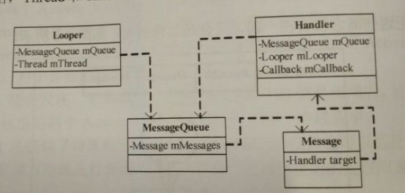消息处理机制主要对象:Looper,Handler,Message(还有MessageQueue和Runnable)
Looper不断从MessageQueue消息队列中取出一个Message,然后传给Handle,如此循环往复,如果队列为空,那么它会进入休眠。
这些类的主要变量
Looper.java
static final ThreadLocal sThreadLocal = new ThreadLocal();
private static Looper sMainLooper; // guarded by Looper.class
final MessageQueue mQueue;
final Thread mThread;
Handler.java
final MessageQueue mQueue;
final Looper mLooper;
final Callback mCallback;
final boolean mAsynchronous;
IMessenger mMessenger;
Message.java
Handler target;每个消息只能对应一个handler
Runnable callback;回调接口
MessageQueue.java
Message mMessages;
Runnable是一个空接口类,没有变量
上一个书上的图:

Handler和Thread没有直接关系,但对应关系可以推理得到
每个Thread只对应一个Looper;
每个Looper只对应一个MessageQueue;
每个MessageQueue对应N个Message,每个Message只对应一个Handler
==》每个Thread对应N个Handler。
Handler是”真正处理事情“的地方,作用:处理消息,将Message压入MessageQueue中
带着一个问题看源码:创建handler对象的线程(ui/主线程除外)为什么,必须先调用Looper.prepare() ?
public Handler() {
this(null, false);
}
public Handler(Callback callback) {
this(callback, false);
}
public Handler(Looper looper) {
this(looper, null, false);
}
public Handler(Looper looper, Callback callback) {
this(looper, callback, false);
}
public Handler(boolean async) {
this(null, async);
}
public Handler(Callback callback, boolean async) {
if (FIND_POTENTIAL_LEAKS) {
final Class extends Handler> klass = getClass();
if ((klass.isAnonymousClass() || klass.isMemberClass() || klass.isLocalClass()) &&
(klass.getModifiers() & Modifier.STATIC) == 0) {
Log.w(TAG, "The following Handler class should be static or leaks might occur: " +
klass.getCanonicalName());
}
}
mLooper = Looper.myLooper();
if (mLooper == null) {
throw new RuntimeException(
"Can't create handler inside thread that has not called Looper.prepare()");
}
mQueue = mLooper.mQueue;
mCallback = callback;
mAsynchronous = async;
}
public Handler(Looper looper, Callback callback, boolean async) {
mLooper = looper;
mQueue = looper.mQueue;
mCallback = callback;
mAsynchronous = async;
}
初始化handler对象时(构造方法是Handler(),Handler(Callback callback))都间接调用Handler(Callback callback, boolean async)构造方法
主要代码是Looper.myLooper();
static final ThreadLocal sThreadLocal = new ThreadLocal();//这是在Looper类中的定义
public static Looper myLooper() {
return sThreadLocal.get();//从当前线程中获得looper对象
}
public static void prepare() {
prepare(true);
}
private static void prepare(boolean quitAllowed) {
if (sThreadLocal.get() != null) {
throw new RuntimeException("Only one Looper may be created per thread");
}
sThreadLocal.set(new Looper(quitAllowed));//为当前线程设置looper对象
}
我们自己创建线程必须通过Looper.prepare()方法为当前线程设置looper对象才可以通过Looper.myLooper()方法返回looper对象,这样在非UI线程创建handler对象时才不会报错。"Can't create handler inside thread that has not called Looper.prepare()"
ps:prepare(boolean quitAllowed)(这个不用我们关心,略过。。)
这个quitAlowed参数是定义消息队列用了,看的源代码是android4.4
Looper.javaprivate Looper(boolean quitAllowed) {
mQueue = new MessageQueue(quitAllowed);
mRun = true;
mThread = Thread.currentThread();
}MessageQueue.java
// True if the message queue can be quit. private final boolean mQuitAllowed;//true消息队列可以被quit,false消息队列不能被quit。
主线程/UI线程的MessageQueue不能被销毁掉。看源码(销毁调用Looper.quit())
public static void prepareMainLooper() {
prepare(false);
synchronized (Looper.class) {
if (sMainLooper != null) {
throw new IllegalStateException("The main Looper has already been prepared.");
}
sMainLooper = myLooper();
}
}
偏离太远了
所以得出结论:创建handler对象的线程(ui/主线程除外),必须先调用Looper.prepare()
Handler作用1:处理消息
在Looper类中处理消息是通过msg.target.dispatchMessage(msg);target就是handler对象(Message类的内部变量Handler target)将消息转发到处理消息的对应的handler对象上,然后这个target即handler对象会在处理消息前做一个检查
public void dispatchMessage(Message msg) {
if (msg.callback != null) {//如果msg有绑定callback回调接口Runaable不为空,则执行Runnable的run方法
handleCallback(msg);
} else {
if (mCallback != null) {//如果handler的内置接口类Callback不为空,则执行boolean handleMessage(Message msg)这个方法
if (mCallback.handleMessage(msg)) {执行完成则return
return;
}
}
handleMessage(msg);//最后才执行handler本身的方法
}
}
private static void handleCallback(Message message) { message.callback.run(); }
public interface Callback {//handler的内置接口类Callback
public boolean handleMessage(Message msg);
}
Handler作用2:将Message压入MessageQueue中
handler中提供的很多发送message的方法,除了sendMessageAtFrontOfQueue()方法(直接调用enqueueMessage(queue, msg, 0);)之外,其它的发送消息方法最终都会辗转调用到sendMessageAtTime()方法
public boolean sendMessageAtTime(Message msg, long uptimeMillis) {
MessageQueue queue = mQueue;
if (queue == null) {
RuntimeException e = new RuntimeException(
this + " sendMessageAtTime() called with no mQueue");
Log.w("Looper", e.getMessage(), e);
return false;
}
return enqueueMessage(queue, msg, uptimeMillis);
}
sendMessageAtTime()方法也是调用Handler中的enqueueMessage(queue, msg, uptimeMillis)方法
和sendMessageAtFrontOfQueue()方法两者最后都会调用enqueueMessage(queue, msg, uptimeMillis)方法
区别是需要延迟uptimeMillis时间后才将Message压入MessageQueue中
private boolean enqueueMessage(MessageQueue queue, Message msg, long uptimeMillis) {
msg.target = this;//给msg的target赋值为handler自身然后加入MessageQueue中
if (mAsynchronous) {
msg.setAsynchronous(true);
}
return queue.enqueueMessage(msg, uptimeMillis);
}
最终所有的方法都是调用MessageQueue中的enqueueMessage(msg, uptimeMillis);方法,是不是感觉两个方法差不多啊,注意参数!!
MessageQueue的使用是在Looper中
Handler的作用整理完毕(好像我现在已经可以把Handler源码完整默写下来了。哈哈^.^记忆力真不行)
Looper类
作用:与当前线程绑定,保证一个线程只会有一个Looper实例,同时一个Looper实例也只有一个MessageQueue。
对于Looper主要是prepare()和loop()两个方法
prepare()将普通线程转化为looper线程,
loop()方法,不断从MessageQueue中去取消息,交给消息的target属性的dispatchMessage去处理。
public static void loop() {
final Looper me = myLooper();
if (me == null) {
throw new RuntimeException("No Looper; Looper.prepare() wasn't called on this thread.");
}
final MessageQueue queue = me.mQueue;
// Make sure the identity of this thread is that of the local process,
// and keep track of what that identity token actually is.
Binder.clearCallingIdentity();
final long ident = Binder.clearCallingIdentity();
for (;;) {
Message msg = queue.next(); // might block
if (msg == null) {
// No message indicates that the message queue is quitting.
return;
}
// This must be in a local variable, in case a UI event sets the logger
Printer logging = me.mLogging;
if (logging != null) {
logging.println(">>>>> Dispatching to " + msg.target + " " +
msg.callback + ": " + msg.what);
}
msg.target.dispatchMessage(msg);
if (logging != null) {
logging.println("<<<<< Finished to " + msg.target + " " + msg.callback);
}
// Make sure that during the course of dispatching the
// identity of the thread wasn't corrupted.
final long newIdent = Binder.clearCallingIdentity();
if (ident != newIdent) {
Log.wtf(TAG, "Thread identity changed from 0x"
+ Long.toHexString(ident) + " to 0x"
+ Long.toHexString(newIdent) + " while dispatching to "
+ msg.target.getClass().getName() + " "
+ msg.callback + " what=" + msg.what);
}
msg.recycle();
}
}
27行就是上面提到了,handler进行消息处理的关键代码了
看着上面的分析很复杂,总结下
1、首先Looper.prepare()为在当前线程中保存一个Looper实例(sThreadLocal.set()),然后该实例中保存一个MessageQueue对象;因为Looper.prepare()在一个线程中只能调用一次,所以MessageQueue在一个线程中只会存在一个。
2、Looper.loop()会让当前线程进入一个无限循环,不端从MessageQueue的实例中读取消息,然后回调msg.target.dispatchMessage(msg)方法。
3、Handler的构造方法,会首先得到当前线程中保存的Looper实例,进而与Looper实例中的MessageQueue想关联。
4、Handler的sendMessage方法,会给msg的target赋值为handler自身,然后加入MessageQueue中。
5、在构造Handler实例时,我们会重写handleMessage方法,也就是msg.target.dispatchMessage(msg)最终调用的方法。
好了,总结完成,大家可能还会问,那么在Activity中,我们并没有显示的调用Looper.prepare()和Looper.loop()方法,为啥Handler可以成功创建呢,这是因为在Activity的启动代码中,已经在当前UI线程调用了Looper.prepare()和Looper.loop()方法。
以上就是本文的全部内容,希望对大家的学习有所帮助,也希望大家多多支持脚本之家。





















 280
280











 被折叠的 条评论
为什么被折叠?
被折叠的 条评论
为什么被折叠?








